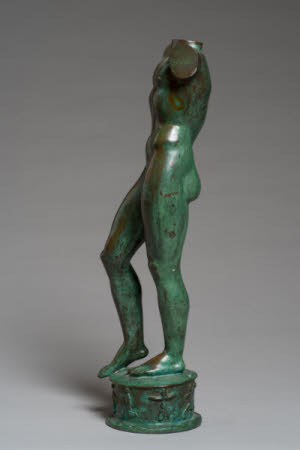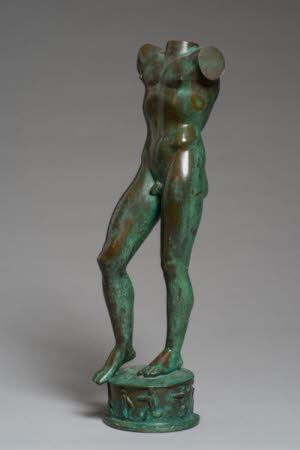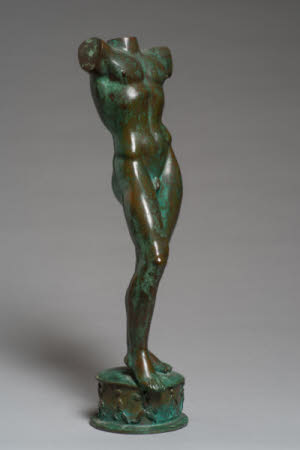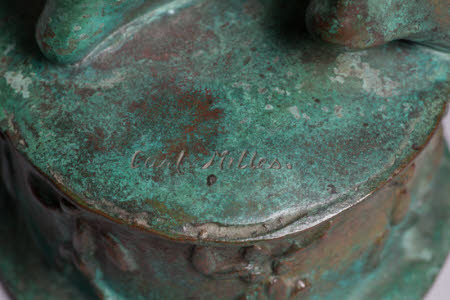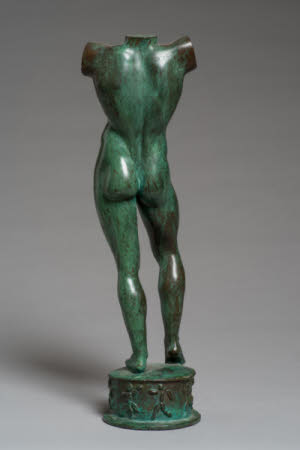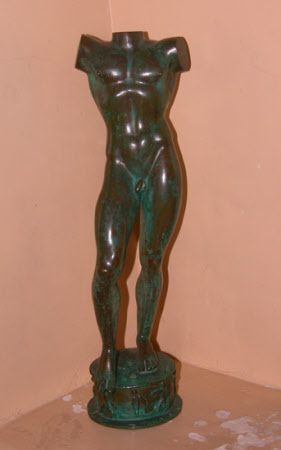The Sun Singer (Solsångaren)
Carl Milles (Langan 1875 - Lidingö 1955)
Category
Art / Sculpture
Date
1930 - 1931
Materials
Bronze
Measurements
333 x 95 mm
Place of origin
Stockholm
Order this imageCollection
Anglesey Abbey, Cambridgeshire
NT 515061
Summary
Bronze, The Sun Singer (Solsångaren), by Carl Milles (1875-1955), 1930-1931. A bronze torso of a naked man by Carl Milles, a model for the colossal bronze figure of Apollo which surmounts one of the sculptor’s best-known works, the Sun Singer monument to the Swedish poet Esaias Tegnér, commissioned in 1918 and completed in 1926. The figure stands right leg forward, arms and head cut off in the model, upon a circular base, decorated with a frieze of small running figures in relief, representing the Muses. The figure is reminiscent of antique torsos in its form and is patinated green, to imitate the effect of an ancient Greek bronze.
Full description
Carl Milles was one of the most significant sculptors of the Art Deco movement, fashionable in the early decades of the twentieth century. Born in Sweden, he spent time as a young man in Paris, where he was employed for a time in Rodin’s workshop, and then in Munich. In 1909 he returned to Sweden and began to develop his career, purchasing a property on the island of Lidingö near Stockholm, where he established his studio and created a sculpture garden. Known today as Millesgården, the garden displays casts of many of Milles’ best-known works. In 1931, Milles became resident sculptor and head of the Department of Sculpture at the Cranbrook Academy of Art in Bloomfield Hills, Michigan, where he worked for the next twenty years, receiving many commissions from American and Swedish clients in particular. For a general summary in English of Milles’ life and work, see Alistair Duncan, Art Deco Sculpture, London 2016, pp. 152-55. The torso is a study for the monument to the poet Esaias Tegnér (1782-1846), which was commissioned from Milles by the Swedish Academy of Letters in 1918 (M.P.-Verneuil, Carl Milles. Sculpteur Suédois, 2 vols., Paris/Brussels 1929, I, pp. 58, II, Pl. 38; Henrik Cornell, ‘Carl Milles Hans Verk’, Sveriges Allmänna Konstförenings Publikation, LXXII (1963), pp. 50-53). The Academy had only wanted a bust of the poet, but Milles insisted that the monument should fully celebrate Tegnér’s creative genius. He took his inspiration from two lines, ‘To you I sing a song, to you, oh radiant sun’, from one of Tegnér’s most famous poems, Song to the Sun (Sång till solen), written around 1810. The male figure of the Sun Singer is in fact a representation of Apollo, god of the sun in the ancient world. The monument to Tegnér was completed in 1926 and placed in the Strömparterren park in Stockholm. The colossal bronze figure of Apollo, roughly twice life-size and much more monolithic in its handling than the small torso, is placed upon a tall granite column, which has a marble medallion of Tegnér on its front. Apollo’s arms are outspread to welcome and invoke the sun. He wears a helmet embellished with a depiction of the rearing horse Pegasus, whilst under his right foot is placed a tortoise, referring to the first lyre, which was made of tortoise shell by the messenger god Hermes (Mercury) and was given by him to Apollo. The base has a frieze of shallow relief figures of the nine Muses who served Apollo. Another large scale version of the Sun Singer is in Allerton Park, Monticello, Illinois, and there is one more in National Memorial Park south of Falls Church, Virginia, close to Washington, D.C. The torso, which evokes sculptures from classical antiquity, was made in a monumental-sized version in the Millesgården, Stockholm (Verneuil, Carl Milles, I, p. 106, fig. 52, II, Pls. 120-22; Meyric R. Rogers, Carl Milles: an Interpretation of his Work (New Haven 1940, p. 51, Pl. 27), and in two smaller sizes. An example of the first of these, with a height of 91 cms., is today in the collections of Tate (Inv. T02105; Ronald Alley, Catalogue of The Tate Gallery’s Collection of Modern Art other than works by British Artists, London 1981, pp. 517-18). Apparently made in 1922, this cast once belonged to the art critic William Kineton Parkes (1865-1938), an early admirer in Britain of Milles' sculpture. The figures of the Muses on the base are rather more detailed in this medium-sized cast than in the small version at Anglesey Abbey, an example of which is also in the Millesgården collections (Carl Milles Sculpture. North American Tour 1998-2000, exh. cat. City Art Museum, St Louis and other venues, Washington D.C. 1998, p. 45, no. 12); resin casts of it may be bought from the Millesgården museum shop today. The Anglesey Abbey bronze is stamped as having been cast in the Herman Bergman Bronze Foundry in Stockholm, which still operates to this day. Milles probably still had his torso model in mind when he began to work on the colossal figure of Poseidon, god of the sea, who crowns another key work, the Poseidon Fountain in Gothenburg, completed in 1931. The figure, with its right leg firmly placed forward and torso slightly twisted as figure looks to its left, is very close to the pose of Poseidon in models and on the completed fountain (Rogers, Carl Milles, pp. 54-55, Pls. 63-83; Cornell, ‘Carl Milles Hans Verk’, pp. 76-82). Jeremy Warren 2019
Provenance
Acquired by 1940; identifiable in the Anglesey Abbey inventory 1940, p. 152, Library, valued at £75; bequeathed to the National Trust by Huttleston Rogers Broughton, 1st Lord Fairhaven (1896-1966) with the house and the rest of the contents.
Credit line
Anglesey Abbey, The Fairhaven Collection (The National Trust)
Marks and inscriptions
On surface of base, towards back: Carl Milles. On lower edge of socle: Herman Bergman fud. [Herman Bergman cast this]
Makers and roles
Carl Milles (Langan 1875 - Lidingö 1955), sculptor
References
'Anglesey Abbey, Lode, Cambridgeshire. An Inventory and Valuation of Furniture, Books, Ornamental Items & Household Effects .. prepared for Insurance Purposes’, Turner, Lord and Ransom, April 1940, p. 152.
